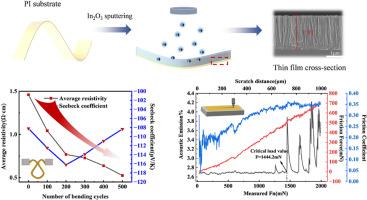具有柱状结构的柔性In2O3薄膜,可增强弯曲耐久性
IF 4.2
3区 材料科学
Q2 MATERIALS SCIENCE, MULTIDISCIPLINARY
引用次数: 0
摘要
柔性电子产品在可穿戴设备、柔性显示器和生物医学方面具有巨大的应用潜力;然而,传统导电材料的脆性限制了其在柔性器件中的应用。本文采用磁控溅射法制备了柔性In2O3薄膜,并对其微观结构、电学性能、界面附着力和动态弯曲耐久性进行了测试。结果表明,In2O3薄膜由沿(400)和(222)晶面取向的高度排列的柱组成,在弯曲试验中具有很强的机械稳定性。电阻率随弯曲次数的增加而减小,500次弯曲后达到0.525 Ω cm,塞贝克系数略有降低,表现出自优化行为。柱状In2O3薄膜与柔性衬底之间的结合力为1444.2 mN,具有良好的界面附着力和抗弯曲性能。这是由于In2O3薄膜中氧空位与衬底分子之间的化学键和柱状结构的纳米级机械联锁的协同作用。该研究为高性能柔性电极提供了理论和实验支持,在可穿戴电子和柔性热电转换方面具有广阔的应用前景。本文章由计算机程序翻译,如有差异,请以英文原文为准。

Flexible In2O3 thin film with columnar structure for enhanced bending durability
Flexible electronics hold significant potential for applications in wearable devices, flexible displays, and biomedicine; however, the brittleness of traditional conductive materials limits their use in flexible devices. In this study, flexible In2O3 thin films were fabricated using magnetron sputtering, and their microstructure, electrical properties, interfacial adhesion, and dynamic bending durability were examined. The results show that the In2O3 film consists of highly aligned columns oriented along the (400) and (222) crystal planes, providing strong mechanical stability during bending tests. The resistivity decreases with repeated bending and reaches 0.525 Ω cm after 500 cycles, accompanied by a slight reduction in the Seebeck coefficient, indicating self-optimizing behavior. The excellent interfacial adhesion and bending resistance are also attributed to the strong bonding between the columnar In2O3 thin film and the flexible substrate, with an adhesion force of 1444.2 mN. This results from the synergistic effect of nanoscale mechanical interlocking from the columnar structure and chemical bonding between oxygen vacancies in the In2O3 film and substrate molecules. This study offers both theoretical and experimental support for high-performance flexible electrodes, with promising applications in wearable electronics and flexible thermoelectric conversion.
求助全文
通过发布文献求助,成功后即可免费获取论文全文。
去求助
来源期刊

Optical Materials
工程技术-材料科学:综合
CiteScore
6.60
自引率
12.80%
发文量
1265
审稿时长
38 days
期刊介绍:
Optical Materials has an open access mirror journal Optical Materials: X, sharing the same aims and scope, editorial team, submission system and rigorous peer review.
The purpose of Optical Materials is to provide a means of communication and technology transfer between researchers who are interested in materials for potential device applications. The journal publishes original papers and review articles on the design, synthesis, characterisation and applications of optical materials.
OPTICAL MATERIALS focuses on:
• Optical Properties of Material Systems;
• The Materials Aspects of Optical Phenomena;
• The Materials Aspects of Devices and Applications.
Authors can submit separate research elements describing their data to Data in Brief and methods to Methods X.
 求助内容:
求助内容: 应助结果提醒方式:
应助结果提醒方式:


